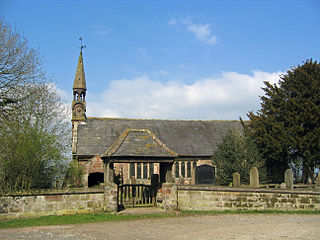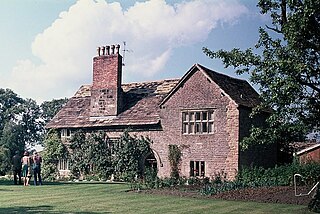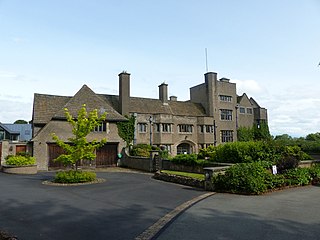
Tabley House is an English country house in Tabley Inferior, some 3 kilometres (1.9 mi) to the west of the town of Knutsford, Cheshire. The house is recorded in the National Heritage List for England as a designated Grade I listed building. It was built between 1761 and 1769 for Sir Peter Byrne Leicester, to replace the nearby Tabley Old Hall, and was designed by John Carr.

Adlington Hall is a country house near Adlington, Cheshire. The oldest part of the existing building, the Great Hall, was constructed between 1480 and 1505; the east wing was added in 1581. The Legh family has lived in the hall and in previous buildings on the same site since the early 14th century. After the house was occupied by Parliamentary forces during the Civil War, changes were made to the north wing, including encasing the Great Hall in brick, inserting windows, and installing an organ in the Great Hall. In the 18th century the house was inherited by Charles Legh who organised a series of major changes. These included building a new west wing, which incorporated a ballroom, and a south wing with a large portico. It is possible that Charles Legh himself was the architect for these additions. He also played a large part in planning and designing the gardens, woodland and parkland, which included a number of buildings of various types, including a bridge known as the Chinese Bridge that carried a summerhouse.

All Saints Church is a redundant Anglican church in the village of Harthill, Cheshire, England. It is recorded in the National Heritage List for England as a designated Grade II* listed building. As of 2010 the church is being converted into a community facility for the village and locality.

St Peter's Church stands in an isolated position to the south of the village of Delamere, Cheshire, England. The church is recorded in the National Heritage List for England as a designated Grade II listed building. It is an active Anglican parish church in the diocese of Chester, the archdeaconry of Chester and the deanery of Middlewich.

Chorley Old Hall is a moated manor house on the B5359 road to the southwest of Alderley Edge, Cheshire, England. The house is recorded in the National Heritage List for England as a designated Grade I listed building, and the moated site is a scheduled monument. It is the oldest inhabited country house in Cheshire and consists of two ranges, one medieval and the other Elizabethan.

Tirley Garth is a large country house some 2.5 miles (4 km) to the north of Tarporley, Cheshire, England. The house together with its entrance courtyard walls are recorded in the National Heritage List for England as a designated Grade II* listed building.

The Falcon is a public house in Chester, Cheshire, England. It stands on the west side of Lower Bridge Street at its junction with Grosvenor Road. The Falcon is recorded in the National Heritage List for England as a designated Grade I listed building. The building formerly incorporated part of Chester Rows, but it was the first building to have its portion of the row enclosed in the 17th century.

31 and 33 Dee Banks is a pair of semi-detached houses in Chester, Cheshire, England. The houses are recorded in the National Heritage List for England as a designated Grade II listed building. The historical importance of the houses, in addition to their listing, is that they were designed by the Chester architect John Douglas, who lived in No. 33 for 20 years.

1–11 and 13 Bath Street consists of a row of six attached cottages and a separate town house on the east side of Bath Street, Chester, Cheshire, England. Both the row of cottages and the house are recorded in the National Heritage List for England as designated Grade II listed buildings.

Birtles Hall is a country house in the parish of Over Alderley, Cheshire, England. It was built in about 1819 for the West Indies merchant Robert Hibbert.

Lower Huxley Hall is a moated manor house in Cheshire, England, located about 6.5 miles (10 km) southeast of Chester. It lies roughly halfway between the villages of Huxley and Hargrave, It dates from the late 15th century, with major additions and alterations in the 17th century. A small addition was made to the rear in the 19th century. It was originally a courtyard house, but only two wings remain. The house is designated by English Heritage as a Grade II* listed building.
Lymm Hall is a moated country house in the village suburb of Lymm in Warrington, Cheshire, England. It is recorded in the National Heritage List for England as a designated Grade II* listed building.

Ramsdell Hall is a country house in the parish of Odd Rode in Cheshire, England, overlooking the Macclesfield Canal. It was built in two phases during the 18th century, and is still in private ownership.
Reaseheath Old Hall is a former country house in the parish of Worleston, to the north of Nantwich in Cheshire, England. It was bought in 1722 by the Tomkinson family of Dorfold. The house was rebuilt in 1878 in Queen Anne style with Jacobean features, and enlarged in 1892. It is now part of Reaseheath College. The house is constructed in brick on a sandstone plinth, with a slated roof. It has three storeys, is in five bays, and has an L-shaped plan. The central bay projects forward and has a gable pediment. In the middle storey is a three-light lunette window. The house is recorded in the National Heritage List for England as a designated Grade II listed building.

Shotwick Hall is a former manor house in the village of Shotwick, Cheshire, England. It replaced an earlier manor house that stood on a moated site some 150 metres to the west. The hall and four associated structures are listed buildings, and the moated site is a Scheduled Monument.

Somerford Booths Hall is a grade II* listed country house in the parish of Somerford Booths, Cheshire, England, 3 kilometres (1.9 mi) northwest of Congleton on the bank of the River Dane.

Whirley Hall is a country house standing to the north of the village of Henbury, Cheshire, England. The house dates from about 1670. Additions and alterations were made during the 18th century and in the 1950s, when the house was restored and wings were added at the sides. The house is constructed in brick with buff sandstone dressings, and has a Kerridge stone-slate roof with stone ridges. It has three storeys and symmetrical five-bay front. Between the storeys, and above the top storey, are brick bands. The lower two storeys contain 20th-century wooden-framed mullioned and transomed windows. In the top storey are two-light casement windows. Above these are two shaped gables, each surmounted by an obelisk finial, and containing an elliptical window. There are single-storey, two-bay extensions on each side of the house. In the roof of the house is a stone inscribed with the date 1599, which is considered to have been removed from an earlier timber-framed house. The house is recorded in the National Heritage List for England as a designated Grade II* listed building. The gate pier in front of the house is a Grade II listed building.
Willot Hall is a country house in the parish of Prestbury, some 4.5 km to the east of Wilmslow, Cheshire, England. It originated as a medieval hall house in the later part of the 15th century. This was encased in stone in the 17th century. Later in the century a service wing was added. The house was restored and extended between 1933 and 1939, moving the entrance and reopening the great hall to the roof. It is constructed partly in buff sandstone rubble and partly in brick, with Kerridge stone slate roofs. It is in 2½ storeys, with a four-bay entrance front, the left bay being larger than the others. The left bay contains mullioned windows and is gabled. The other bays contain a doorway, smaller mullioned windows, and have gabled dormers. The house is recorded in the National Heritage List for England as a designated Grade II* listed building.

Oakfield Manor was originally a country house in Upton by Chester, near Chester, Cheshire, England. Since the 1930s it has been the headquarters of Chester Zoo. The house and its stables are recorded separately in the National Heritage List for England as designated Grade II listed buildings.
Willington is a civil parish in Cheshire West and Chester, England. It contains nine buildings that are recorded in the National Heritage List for England as designated listed buildings. Of these, one is listed at Grade II*, the middle grade, and the others are at Grade II. The parish is entirely rural, and contains two listed country houses, Tirley Garth and Willington Hall, both of which are listed. The other listed structures are associated with these houses, plus a farmhouse.

















